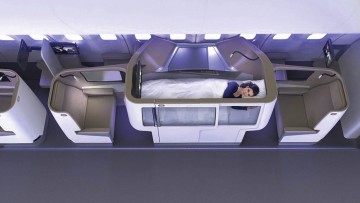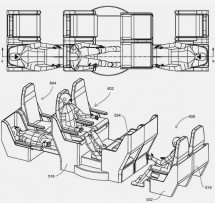Business and first class cabins have always been at the forefront of airline industrial design, aiming to please customers’ eyes as much as their bodies. During a period of immense investment by airlines worldwide, new concepts and design inspiration create more space as if by magic from the finite confines of the airliner interior.
Premium services, dating back to the days of Concorde, which flew in a two-two configuration using seats that would now be substandard in long-haul premium economy, have rarely been innovative in their passenger experience because convenience is all the attraction they needed.
First class is starting to move beyond the seat-in-a-suite concept and Etihad promises its ‘above first class’ three-room The Residence is not just a halo product
This trend continues with some business class transatlantic offerings such as La Compagnie and British Airways’ Airbus A318 London City-New York JFK services by no means class-leading in either inflight cabin or seating.
Beyond first class
Almost ten years after the introduction of the first class suite, on Singapore Airlines’ and the world’s first Airbus A380, much business and first class innovation today comes from the large network carriers, most recently and notably Etihad’s Airbus A380 and Boeing 787-9 cabins.
First class is starting to move beyond the seat-in-a-suite concept and the Abu Dhabi-based airline’s “above first class” three-room The Residence is, Etihad promises, not just a halo product. The Residence is positioned ahead of the innovative and spacious first class apartments, which contain both a plush leather recliner and a sofa that converts into a bed. The apartment beds are perpendicular to the cabin’s single aisle, creating a space wider than it is long. Local rival Emirates has promised to outdo Etihad’s products, but as yet has not shown its hand.

Bar arca for business class passengers of Qatar Airways
Etihad’s 787-9 cabins, however, are perhaps even more innovative in their use of space, with a pair of curved aisles and forwards-backwards layout that enable extra shoulder room through the use of smart design. A forwards-backwards layout optimises space in Etihad’s business class too, with a staggered effect offering direct aisle access for every passenger.
In the 16 years since British Airways pioneered the fully flat bed in business class, many airlines have either tried to trump its density or market themselves as more luxurious and spacious. The latter has been more successful than the former, with BA’s lack of direct aisle access for every passenger, increasingly the standard for airlines that want to attract the most valuable customer, now feeling long in the tooth.
Direct aisle access is achieved in a number of space-efficient ways. Initially, Virgin Atlantic achieved its direct aisle access goal by angling seats in a herringbone fashion, facing towards the aisle. Later, seatmaker Zodiac Aerospace created the Cirrus seat, facing away from the aisle. US Airways, now American Airlines, launched Cirrus, but the seat was popularised by the Cathay Pacific/JPA Design customisation that American Airlines itself uses on its Boeing 777-300ER aircraft.
One potential option for an airline not convinced it needs a separate first class cabin is a new concept from US-based Formation Design that literally raises the best seats above the rest, making the most of the three-dimensional space in the cabin that only Stelia’s Equinox 3D seats, as seen on Philippine Airlines, have done in the past. Building on the concept “throne” seats in alternating rows that come from the staggered Vantage seats designed by Thompson Aero, Formation would quite literally put the best seats on a pedestal.
Collaborating with designers
In addition to aiming to become luxury lifestyle brands themselves, airlines are increasing the number of other marques with which they affiliate themselves. Designer labels such as Ferragamo and Bulgari or upmarket luggage-makers like Rimowa and Tumi, have long collaborated with airlines to produce airline amenity kits. Numerous airlines now work with car companies to transport first, and occasionally business, class passengers around airports, with Lufthansa’s First Class Terminal in Frankfurt perhaps the best known example.

New lie-flat seating concept by Formation Design with elevated staggered beds to make the most of the cabin space
The use of luxury furnishing brands such as Poltrona Frau on carriers including Singapore Airlines and Etihad, luxury foods like Ladurée patisserie on Etihad or Balik salmon on Cathay Pacific and Singapore Airlines, and even liquors in Absolut-branded bars on Korean Air’s Airbus A380 are all part of this trend.
Champagne and wine, of course, have long been an opportunity for a carrier to demonstrate its dedication to the palates of its first and business class customers, with airlines among the largest consumers of the French fizz worldwide. Dom Pérignon and Krug are de rigeur in top-ranked first classes, while more boutique options such as Salon on Japan Airlines and the Perrier-Jouët Belle Époque Blanc de Blancs on some Korean Air routes push the boat out.
New materials, too, enable real-feel wood flooring, as well as sweeping curves of plastic surfaces that draw from the Eames legacy of modernism and mid-century design. With the likes of Sekisui SPI creating revolutionary thermoplastics that look almost like they change colours in increasingly mood-lit cabins, airlines can use both light and shade to set the scene for luxury, chic or glamorous flying.

Lie-flat concept
Mood lighting also enables changes in the intensity and blue-yellow spectrum of light, which means lights that resemble the warm glow of a tungsten lightbulb during the evening, leading to more restful sleep and a softer, less jarring wake-up call in the morning.
Pulling all these innovations together are the new breed of design house collaborations. All Etihad’s latest seats were created by the Etihad Design Consortium, a group incorporating Acumen, Factorydesign and Honour Branding, for example. It’s rare these days to find a new business or first class seat being released without a design partner to help combine all the modern materials, airline economics and cutting-edge manufacturing into new and exciting options.
Business and first class cabins have always been at the forefront of airline industrial design, aiming to please customers’ eyes as much as their bodies. During a period of immense investment by airlines worldwide, new concepts and design inspiration create more space as if by magic from the finite confines of the airliner interior.
Premium services, dating back to the days of Concorde, which flew in a two-two configuration using seats that would now be substandard in long-haul premium economy, have rarely been innovative in their passenger experience because convenience is all the attraction they needed.
First class is starting to move beyond the seat-in-a-suite concept and Etihad promises its 'above first class' three-room The Residence is not just a halo product
This trend continues with some business class transatlantic offerings such as La Compagnie and British Airways’ Airbus A318 London City-New York JFK services by no means class-leading in either inflight cabin or seating.
